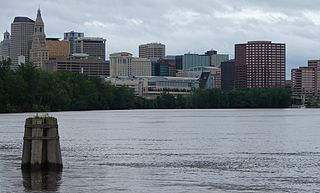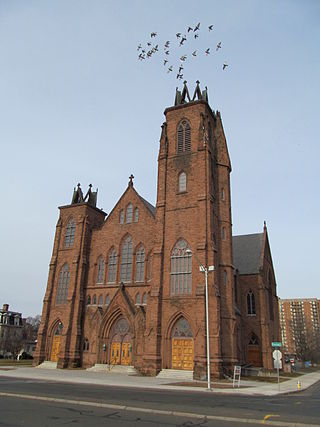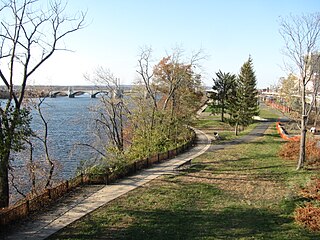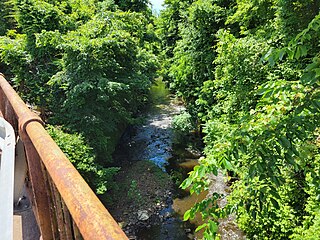
Hampden County is a non-governmental county located in the Pioneer Valley of the U.S. state of Massachusetts, in the United States. As of the 2020 census, Hampden County's population was 465,825. Its traditional county seat is Springfield, the Connecticut River Valley's largest city, and economic and cultural capital; with an estimated population of 154,758, approximately one-third of Hampden County residents live in Springfield.

Interstate 91 (I-91) is an Interstate Highway in the New England region of the United States. It is the primary north–south thoroughfare in the western part of the region. Its southern terminus is in New Haven, Connecticut, at I-95, while the northern terminus is in Derby Line, Vermont, at the Canada–United States border. Past the Derby Line–Rock Island Border Crossing, the road continues into Canada as Quebec Autoroute 55. I-91 is the longest of three Interstate highways whose entire route is located within the New England states and is also the only primary (two-digit) Interstate Highway in New England to intersect all five of the other highways that run through the region. The largest cities along its route, from south to north, are New Haven, Connecticut; Hartford, Connecticut; Springfield, Massachusetts; Northampton, Massachusetts; Greenfield, Massachusetts; Brattleboro, Vermont; White River Junction, Vermont; St. Johnsbury, Vermont; and Newport, Vermont.

Springfield is the most populous city in and the seat of Hampden County, Massachusetts, United States. Springfield sits on the eastern bank of the Connecticut River near its confluence with three rivers: the western Westfield River, the eastern Chicopee River, and the eastern Mill River. At the 2020 census, the city's population was 155,929, making it the third most populous city in the U.S. state of Massachusetts and the fourth most populous city in New England after Boston, Worcester, and Providence. Metropolitan Springfield, as one of two metropolitan areas in Massachusetts, had a population of 699,162 in 2020.

Rowe is a town in Franklin County, Massachusetts, United States. The population was 424 at the 2020 census.

Holyoke is a city in Hampden County, Massachusetts, United States, that lies between the western bank of the Connecticut River and the Mount Tom Range. As of the 2020 census, the city had a population of 38,247. Located 8 miles (13 km) north of Springfield, Holyoke is part of the Springfield Metropolitan Area, one of the two distinct metropolitan areas in Massachusetts.

Westfield is a city in Hampden County, in the Pioneer Valley of western Massachusetts, United States. Westfield was first settled by Europeans in 1660. It is part of the Springfield, Massachusetts Metropolitan Statistical Area. The population was 40,834 at the 2020 census.

Amherst Center is a census-designated place (CDP) in the City of Amherst in Hampshire County, Massachusetts, United States. The CDP covers the primary village in town. The population was 19,065 at the 2010 census, out of a total city population of 37,819. It is part of the Springfield, Massachusetts Metropolitan Statistical Area.

The Pioneer Valley is the colloquial and promotional name for the portion of the Connecticut River Valley that is in Massachusetts in the United States. It is generally taken to comprise the three counties of Hampden, Hampshire, and Franklin. The lower Pioneer Valley corresponds to the Springfield, Massachusetts metropolitan area, the region's urban center, and the seat of Hampden County. The upper Pioneer Valley region includes the smaller cities of Northampton and Greenfield, the county seats of Hampshire and Franklin counties, respectively.

West Springfield is a city in Hampden County, Massachusetts, United States. It is part of the Springfield, Massachusetts Metropolitan Statistical Area. The population was 28,835 at the 2020 United States Census. The city is also known as "West Side", in reference to the fact that it is on the western side of the Connecticut River from Springfield, a fact which played a major part in the town's early history.

The greater Hartford–Springfield area is an urban region and surrounding suburban areas that encompasses both north-central Connecticut and the southern Connecticut River Valley in western Massachusetts; its major city centers are Springfield, Massachusetts and Hartford, Connecticut.

Metro Center is the original colonial settlement of Springfield, Massachusetts, United States, located beside a bend in the Connecticut River. As of 2019, Metro Center features a majority of Western Massachusetts' most important cultural, business, and civic venues. Metro Center includes Springfield's Central Business District, its Club Quarter, its government center, its convention headquarters, and in recent years, it has become an increasingly popular residential district, especially among young professionals, empty-nesters, and creative types, with a population of approximately 7,000 (2010.)

East Forest Park is a neighborhood in the south-central part of Springfield, Massachusetts. The neighborhood borders East Longmeadow, Forest Park, and the Sixteen Acres neighborhood. It is a primarily residential middle-class neighborhood.

The North End of Springfield, Massachusetts, is a name that describes three distinct Springfield neighborhoods: Brightwood, Memorial Square, and Liberty Heights. For more than a century, Springfield's North End neighborhood has served as a first home for some of the city's various immigrant communities, from Greeks in Memorial Square to Russians in Liberty Heights. As of 2011, the contemporary Puerto Rican flavor of the North End is evident in numerous banners depicting traditional Carnival masks and the coquí, Puerto Rico's unofficial mascot.

South End is a neighborhood in the city of Springfield, Massachusetts. Interstate 91 separates it from the Connecticut River and the Basketball Hall of Fame museum and entertainment complex.

The Connecticut River Walk is partially constructed park and bikeway in Springfield, Massachusetts, United States, along the banks of New England's largest river, the Connecticut River. Currently, Springfield's section of this park is 3.7 miles (6 km) long, running from Chicopee, Massachusetts to the South End Bridge in Springfield, Massachusetts. Unusual features of the trail include its path alongside an active train line, making it a "rail-with-trail," and its passing in very close proximity to the Naismith Memorial Basketball Hall of Fame. The longest river in New England, the Connecticut River is the Knowledge Corridor's most prominent natural asset. For centuries it has been a source of regional identity and pride; however, currently most residents are cut off from it by Interstate 91 - a 1960s-era elevated highway, which has become a major inhibitor to Springfield's economic and recreational riverfront growth, especially in recent years.

The City of Springfield, Massachusetts, has 19 distinct neighborhoods. Many feature subdivisions known by other names, such as The X, Hungry Hill, and Mason Square. Springfield's neighborhoods fan out north, south, and east, from its original, colonial settlement in what is now Metro Center.

The Mill River is a 1.25-mile-long (2.01 km) tributary of the Connecticut River in Springfield, Massachusetts. It flows from Watershops Pond to its confluence with the Connecticut River. It is referred to as "The Miracle Mile" in a 2009 master's thesis that outlines possibilities for reclaiming the river's mouth as a recreational area. As of 2011, the final 350 feet (110 m) of the river, including its mouth, is confined in a pipe underneath Interstate 91, railroad tracks and a car dealership. Many Springfield residents have bemoaned the loss of the Mill River as a recreational area, and hope to gain greater access to both it and the Connecticut River in upcoming years. As it has for over a century, today the Mill River serves as a barrier between Springfield neighborhoods. Surrounding it are some of the most densely urbanized locations in Springfield.

This is a list of roundabouts in the state of Massachusetts in the United States. Intersections that are called traffic circles or roundabouts in the rest of the US are referred to as "rotaries" in Massachusetts, as well as other parts of New England including parts of Connecticut, New Hampshire, Maine Rhode Island, & Vermont.

The history of Springfield, Massachusetts dates back to the colonial period, when it was founded in 1636 as Agawam Plantation, named after a nearby village of Algonkian-speaking Native Americans. It was the northernmost settlement of the Connecticut Colony. The settlement defected from Connecticut after four years, however, later joining forces with the coastal Massachusetts Bay Colony. The town changed its name to Springfield, and changed the political boundaries among what later became the states of New England. The decision to establish a settlement sprang in large part from its favorable geography, situated on a steep bluff overlooking the Connecticut River's confluence with three tributaries. It was a Native American crossroad for two major trade routes: Boston-to-Albany and New York City-to-Montreal. Springfield also sits on some of the northeastern United States' most fertile soil.

Ingleside is a neighborhood in Holyoke, Massachusetts located to the south of the city center, approximately 2 miles (3.2 km) from downtown. The neighborhood features access to the Connecticut River through the Sue Ellen Panitch River Center and the Land of Providence reservation. Ingleside is also home to the Holyoke Mall, the Nuestras Raices farm, the Sisters of Providence of Holyoke, the Providence Behavioral Health Hospital, and several recreational and historical venues.




















